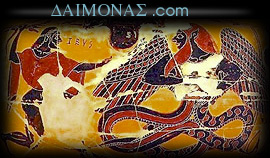
© demetrios vakras  BYZANTINE BASIS OF 'ZOROASTRIAN' MOTIFS |
AUTHOR: about the Daimonas
| |
||
| |
|
|
 |
||
|
There are claims by propagandists (most notably the Frenchman Ghirshman) that Persians had ideas that were their own. Any such claims are only ever supported by arguments of omission. The most original element of Persian/Zoroastrian culture was brutal intolerance of any faith other than that of Zoroaster. This is attested to in the insriptions of the Zoroastrian high priest Kartir: "Kartir called for the persecution of adherents of other religions" ( http://en.wikipedia.org/wiki/Kartir ). Devoid of both their own motifs and of skilled craftsmen successive Persian dynasties such as the Achaemenids and the Sassanids merely filched those of other cultures. Probably the best known example of this kind of filching is the motif of the Assyrian's god Assara Mazaas (Mazas) after whom the "Assyrians" are named, and who was represented as a human figure riding the Egyptian winged-sundisc. When the Achaemenids required sculptors they used Ionian Greek & Carian slaves in both Susa and then Persepolis. The Sassanids, simply enslaved the Greeks of Antioch. This page is related to the Byzantine origins of what are claimed to be "Islamic" ideas. This page is limited to showing the Byzantine/Greek basis of Sassanian ideas which were absorbed by the even less original Arabs who replaced the faith of Zoroaster with one more brutal; that of Mohammed. The Greek influence on Zoroastrian Persian art, which forms the basis of the later so-called "Islamic" art |
 |